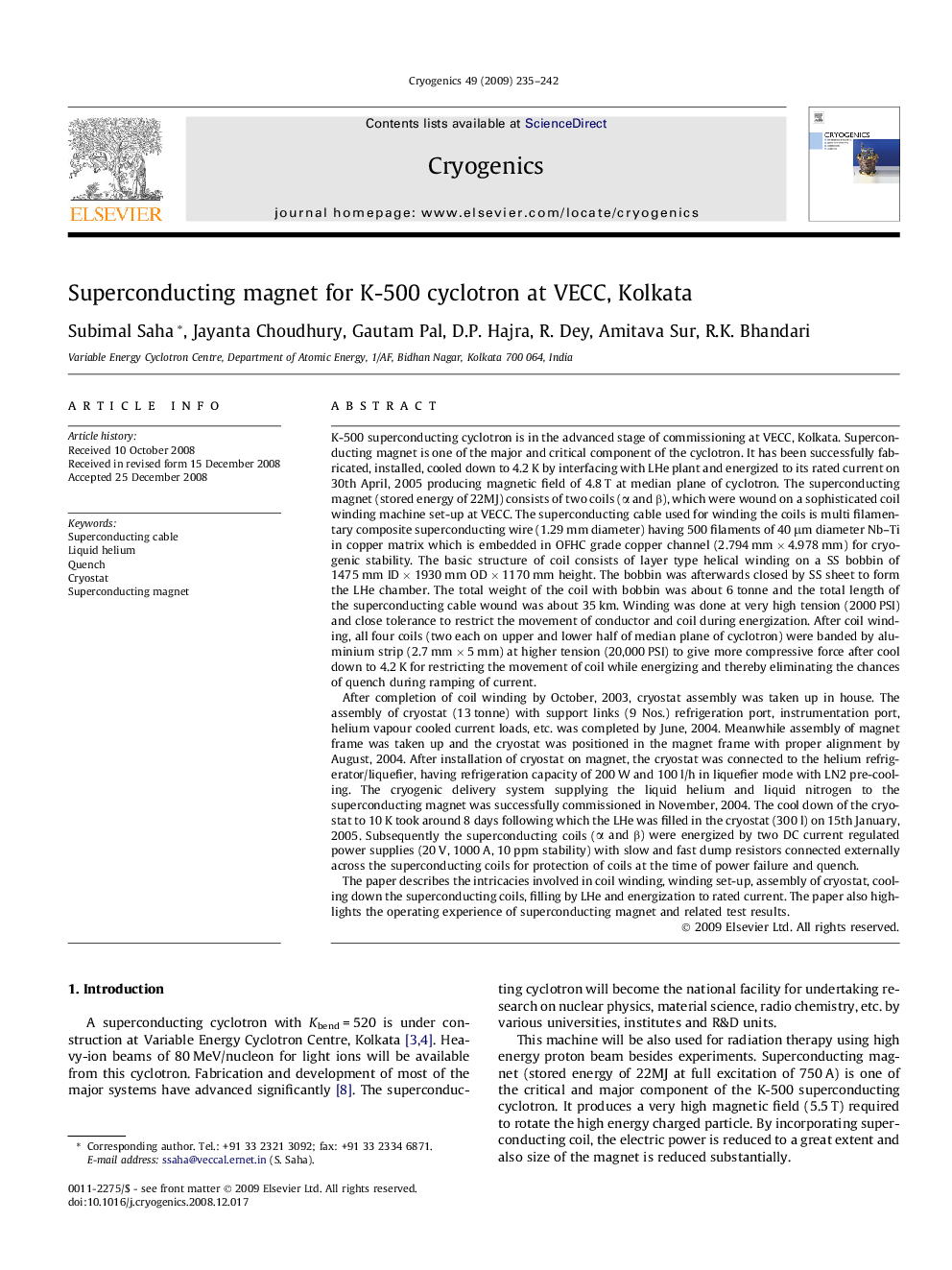| کد مقاله | کد نشریه | سال انتشار | مقاله انگلیسی | نسخه تمام متن |
|---|---|---|---|---|
| 1507996 | 993944 | 2009 | 8 صفحه PDF | دانلود رایگان |

K-500 superconducting cyclotron is in the advanced stage of commissioning at VECC, Kolkata. Superconducting magnet is one of the major and critical component of the cyclotron. It has been successfully fabricated, installed, cooled down to 4.2 K by interfacing with LHe plant and energized to its rated current on 30th April, 2005 producing magnetic field of 4.8 T at median plane of cyclotron. The superconducting magnet (stored energy of 22MJ) consists of two coils (α and β), which were wound on a sophisticated coil winding machine set-up at VECC. The superconducting cable used for winding the coils is multi filamentary composite superconducting wire (1.29 mm diameter) having 500 filaments of 40 μm diameter Nb–Ti in copper matrix which is embedded in OFHC grade copper channel (2.794 mm × 4.978 mm) for cryogenic stability. The basic structure of coil consists of layer type helical winding on a SS bobbin of 1475 mm ID × 1930 mm OD × 1170 mm height. The bobbin was afterwards closed by SS sheet to form the LHe chamber. The total weight of the coil with bobbin was about 6 tonne and the total length of the superconducting cable wound was about 35 km. Winding was done at very high tension (2000 PSI) and close tolerance to restrict the movement of conductor and coil during energization. After coil winding, all four coils (two each on upper and lower half of median plane of cyclotron) were banded by aluminium strip (2.7 mm × 5 mm) at higher tension (20,000 PSI) to give more compressive force after cool down to 4.2 K for restricting the movement of coil while energizing and thereby eliminating the chances of quench during ramping of current.After completion of coil winding by October, 2003, cryostat assembly was taken up in house. The assembly of cryostat (13 tonne) with support links (9 Nos.) refrigeration port, instrumentation port, helium vapour cooled current loads, etc. was completed by June, 2004. Meanwhile assembly of magnet frame was taken up and the cryostat was positioned in the magnet frame with proper alignment by August, 2004. After installation of cryostat on magnet, the cryostat was connected to the helium refrigerator/liquefier, having refrigeration capacity of 200 W and 100 l/h in liquefier mode with LN2 pre-cooling. The cryogenic delivery system supplying the liquid helium and liquid nitrogen to the superconducting magnet was successfully commissioned in November, 2004. The cool down of the cryostat to 10 K took around 8 days following which the LHe was filled in the cryostat (300 l) on 15th January, 2005. Subsequently the superconducting coils (α and β) were energized by two DC current regulated power supplies (20 V, 1000 A, 10 ppm stability) with slow and fast dump resistors connected externally across the superconducting coils for protection of coils at the time of power failure and quench.The paper describes the intricacies involved in coil winding, winding set-up, assembly of cryostat, cooling down the superconducting coils, filling by LHe and energization to rated current. The paper also highlights the operating experience of superconducting magnet and related test results.
Journal: Cryogenics - Volume 49, Issue 6, June 2009, Pages 235–242